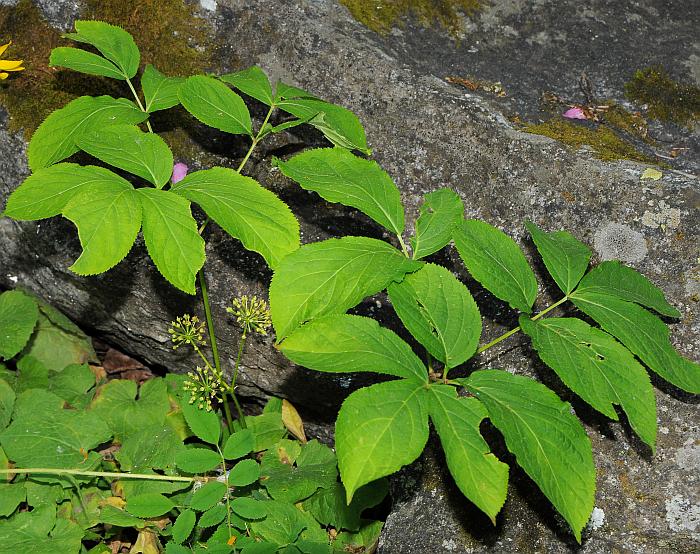Aralia nudicaulis L.
Wild Sarsaparilla

Native
CC = 10
CW = 3
MOC = 2
SRank = S2
© SRTurner
Aralia nudicaulis L.Wild Sarsaparilla | |
 |
Native CC = 10 CW = 3 MOC = 2 SRank = S2 |
© SRTurner |
|
Family - Araliaceae Habit - Perennial forb with long-creeping rhizomes. Stem - Aerial stems absent. Leaves - Basal, usually solitary from the tip of the rhizome, with petioles 15-35 cm long. Blades 15-40 cm long, the 3 main divisions each pinnately divided into 3-5 leaflets, the leaflets 3-15 cm long, narrowly elliptic to broadly ovate, the margins sharply toothed, the upper surface green, the undersurface slightly lighter green, minutely hairy along the larger veins.
Inflorescences - Solitary from the rhizome, a compound umbel with usually 3umbels, the main stalk 8-25 cm long, minutely hairy toward the tip.
Flowers - Mostly perfect, epigynous, actinomorphic. Sepals 5 low, broadly triangular teeth. Petals 5, often promptly deciduous following opening of the flower, oblong-elliptic, 1-2 mm long, white or green. Pistil 1 per flower, composed of 2-5 fused carpels, the ovary inferior with a nectar disc at the tip, the styles usually 5, sometimes fused together toward the base, persistent in fruit.
Fruits - Berrylike drupes 6-10 mm long, maturing to purplish black, usually with 5 stones.
Flowering - May - June. Habitat - Ledges of moist, shaded bluffs, on both calcareous substrates and sandstone. Origin - Native to the U.S. Lookalikes - Panax quinquefolius. Other info. - This interesting plant is very uncommon in Missouri. Its main range is in northern and eastern regions of the continental U.S. (and also Canada), with smaller disjunct populations in northern Washington State and in the Rocky Mountains, where the images above were acquired. Though not showy, the plant is easily identified by its characteristic leaves and inflorescences, which are unique among our flora. Photographs taken in Rocky Mountain National Park, Larimer County, CO, 6-23-2018, 7-9-2019, and 6/17/2020 (SRTurner). |